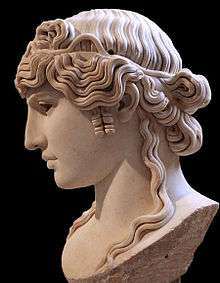Acrolith

An acrolith is a composite sculpture made of stone and other materials, as in the case of a figure whose clothed parts are made of wood, while the exposed flesh parts such as head, hands, and feet are made of marble. The wood was covered either by drapery or by gilding.[1] This type of statuary was common and widespread in Classical antiquity.
Greek etymology: acros and lithos, English translation: "height" or "extremity" and "stone".
Similarly, chryselephantine sculpture used ivory instead of marble, and often gold on parts of the body and ornaments. Acroliths are frequently mentioned by Pausanias (2nd century CE), the best known example being the Athene Areia ("Warlike Athena") of the Plataeans.[1]
Examples of acrolithic sculptures
- Athene Areia of the Plataeans
- Colossus of Constantine
- Antinous Mondragone
- Hera Farnese
- Augustus, dea Roma, Tiberius, Livia from Leptis Magna in Libya
References
- 1 2
 One or more of the preceding sentences incorporates text from a publication now in the public domain: Chisholm, Hugh, ed. (1911). "Acroliths". Encyclopædia Britannica. 1 (11th ed.). Cambridge University Press. p. 155.
One or more of the preceding sentences incorporates text from a publication now in the public domain: Chisholm, Hugh, ed. (1911). "Acroliths". Encyclopædia Britannica. 1 (11th ed.). Cambridge University Press. p. 155.
Secondary sources
- Barrett, Anthony A (2002). Livia,First Lady of Imperial Rome. Yale University Press. ISBN 978-0-300-10298-7.
External links
 Media related to Acrolithic statues at Wikimedia Commons
Media related to Acrolithic statues at Wikimedia Commons
This article is issued from Wikipedia - version of the 5/22/2016. The text is available under the Creative Commons Attribution/Share Alike but additional terms may apply for the media files.